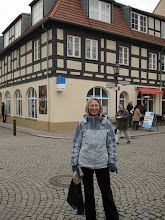 Helsingborg is a very beautiful harbor city. It used to be the main crossing point between Sweden and Denmark with ferries going back and forth every couple of minutes. This is where cars, trains, and trucks loaded onto ferries used to cross. Since the building of the bridge between Malmö and Copenhagen, all trains and most cars and trucks now go across the bridge. Nevertheless, the ferry traffic between Helsingborg and Helsingör (Elsinore) seems to be as profitable and active as ever. Every few minutes there was a ferry full of passengers going over the sound. Why? Because the Swedes go across to buy and bring back huge amounts of beer and wine, which is much cheaper in Denmark.
Helsingborg is a very beautiful harbor city. It used to be the main crossing point between Sweden and Denmark with ferries going back and forth every couple of minutes. This is where cars, trains, and trucks loaded onto ferries used to cross. Since the building of the bridge between Malmö and Copenhagen, all trains and most cars and trucks now go across the bridge. Nevertheless, the ferry traffic between Helsingborg and Helsingör (Elsinore) seems to be as profitable and active as ever. Every few minutes there was a ferry full of passengers going over the sound. Why? Because the Swedes go across to buy and bring back huge amounts of beer and wine, which is much cheaper in Denmark.  The Seafarers' Godess (Sjöfartsgudinnan) by the sculptor Carl Milles protects the harbor.
The Seafarers' Godess (Sjöfartsgudinnan) by the sculptor Carl Milles protects the harbor. Since the trains and trucks do not come here anymore, the old warehouse areas have given way to new construction of condominiums, restaurants, cafes, a boardwalk, and a marina for private boats.
Since the trains and trucks do not come here anymore, the old warehouse areas have given way to new construction of condominiums, restaurants, cafes, a boardwalk, and a marina for private boats. The old city hall.
The old city hall. One of the most famous tourist attractions in Helsingborg is the old fort, Kärnan, also called Helsingborg's Castle. It was built between 1202-1205 and was one of Denmark's most important fortifications. Yes, Helsingborg was a part of Denmark until 1658.
One of the most famous tourist attractions in Helsingborg is the old fort, Kärnan, also called Helsingborg's Castle. It was built between 1202-1205 and was one of Denmark's most important fortifications. Yes, Helsingborg was a part of Denmark until 1658.
 From the top you have a pretty view of the sound and Denmark on the other side.
From the top you have a pretty view of the sound and Denmark on the other side.


 The beautiful Sankta Maria church was first built in the 11th century and then rebuilt in the 15th century. For a few years around 1657-58 one of my favorite composers, Dietrich Buxtehude, was the organist here.
The beautiful Sankta Maria church was first built in the 11th century and then rebuilt in the 15th century. For a few years around 1657-58 one of my favorite composers, Dietrich Buxtehude, was the organist here. Dinner at Olsons Skafferi. Waiting for the food
Dinner at Olsons Skafferi. Waiting for the food Thomas seems to be happy,
Thomas seems to be happy, Arne is not so sure,
Arne is not so sure,Publish Post
 and Eleanor is just looking pretty.
and Eleanor is just looking pretty.
























































